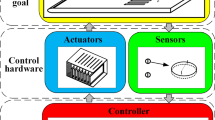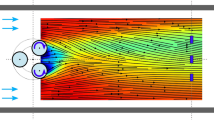Abstract
We experimentally perform open and closed-loop control of a separating turbulent boundary layer downstream from a sharp edge ramp. The turbulent boundary layer just above the separation point has a Reynolds number \(Re_{\theta }\approx 3500\) based on momentum thickness. The goal of the control is to mitigate separation and early re-attachment. The forcing employs a spanwise array of active vortex generators. The flow state is monitored with skin-friction sensors downstream of the actuators. The feedback control law is obtained using model-free genetic programming control (GPC) (Gautier et al. in J Fluid Mech 770:442–457, 2015). The resulting flow is assessed using the momentum coefficient, pressure distribution and skin friction over the ramp and stereo PIV. The PIV yields vector field statistics, e.g. shear layer growth, the back-flow area and vortex region. GPC is benchmarked against the best periodic forcing. While open-loop control achieves separation reduction by locking-on the shedding mode, GPC gives rise to similar benefits by accelerating the shear layer growth. Moreover, GPC uses less actuation energy.
























Similar content being viewed by others
References
Amitay M, Glezer A (2002) Role of actuation frequency in controlled flow reattachment over a stalled airfoil. AIAA J 40(2):209–216
Benard N, Moreau E, Griffin J, Cattafesta LN III (2010) Slope seeking for autonomous lift improvement by plasma surface discharge. Exp Fluids 48(5):791–808
Benedict LH, Gould RD (1996) Towards better uncertainty estimates for turbulence statistics. Exp Fluids 22(2):129–136
Browand FK, Troutt TR (1985) The turbulent mixing layer: geometry of large vortices. J Fluid Mech 158:489–509
Brunton SL, Noack BR (2015) Closed-loop turbulence control: progress and challenges. Appl Mech Rev 67(5):050,801:01–050,801:48
Castro IP, Haque A (1987) The structure of a turbulent shear layer bounding a separation region. J Fluid Mech 179:439–468
Cherry NJ, Hillier R, Latour MEMP (1984) Unsteady measurements in a separated and reattaching flow. J Fluid Mech 144:13–46
Cordier L, Noack BR, Tissot G, Lehnasch G, Delville J, Balajewicz M, Daviller G, Niven RK (2013) Identification strategy for model-based control. Exp Fluids 54:1580
Cuvier C, Braud C, Foucault JM, Stanislas M (2011) Flow control over a ramp using active vortex generators. In: Seventh International Symposium on Turbulence and Shear Flow Phenomena, Ottawa, Canada
Dandois J, Garnier E, Sagaut P (2007) Numerical simulation of active separation control by a synthetic jet. J Fluid Mech 574(1):25–58
Debien A, Aubrun S, Mazellier N, Kourta A (2014) Salient and smooth edge ramps inducing turbulent boundary layer separation: flow characterization for control perspective. C R Mécanique 342(6–7):356–362
Debien A, Aubrun S, Mazellier N, Kourta A (2015) Active separation control process over a sharp edge ramp. In: Ninth International Symposium on Turbulence and Shear Flow Phenomena, Melbourne, Australia
Duriez T, Parezanović V, Laurentie JC, Fourment C, Delville J, Bonnet JP, Cordier L, Noack BR, Segond M, Abel MW, Gautier N, Aider JL, Raibaudo C, Cuvier C, Stanislas M, Brunton S (2014) Closed-loop control of experimental shear layers using machine learning (Invited). In: 7th AIAA Flow Control Conference, Atlanta, Georgia, USA, pp 1–16
Gautier N, Aider JL (2013) Control of the separated flow downstream of a backward-facing step using visual feedback. Proc R Soc A 469(2160):20130,404
Gautier N, Aider JL, Duriez T, Noack BR, Segond M, Abel M (2015) Closed-loop separation control using machine learning. J Fluid Mech 770:442–457
Gerhard J, Pastoor M, King R, Noack BR, Dillmann A, Morzyński M, Tadmor G (2003) Model-based control of vortex shedding using low-dimensional Galerkin models. In: 33rd AIAA Fluids Conference and Exhibit, Orlando, Florida, USA, paper 2003-4262
Godard G, Stanislas M (2006a) Control of a decelerating boundary layer. Part 1: optimization of passive vortex generators. Aerosp Sci Technol 10(3):181–191
Godard G, Stanislas M (2006b) Control of a decelerating boundary layer. Part 3: optimization of round jets vortex generators. Aerosp Sci Technol 10(6):455–464
Greenblatt D, Wygnanski IJ (2000) The control of flow separation by periodic excitation. Prog Aerosp Sci 36(7):487–545
Hasan MAZ (1992) The flow over a backward-facing step under controlled perturbation: laminar separation. J Fluid Mech 238:73–96
Jovic S (1996) An experimental study of a separated/reattached flow behind a backward-facing step. \(Re_h = 37{,}000\). NASA Tech Memo 110384
Kaiser E, Noack BR, Cordier L, Spohn A, Segond M, Abel MW, Daviller G, Östh J, Krajnović S, Niven RK (2014) Cluster-based reduced-order modelling of a mixing layer. J Fluid Mech 754:365–414
King R (ed) (2007) Active flow control I, no. 95 in notes on numerical fluid mechanics and interdisciplinary design. Springer, Berlin
King R (ed) (2010) Active flow control II, no. 108 in notes on numerical fluid mechanics and interdisciplinary design. Springer, Berlin
Koza JR (1992) Genetic programming: on the programming of computers by means of natural selection. The MIT Press, Boston
Koza JR, Bennett FH III, Stiffelman O (1999) Genetic programming as a Darwinian invention machine, vol 1598., Lecture notes in computer scienceSpringer, Berlin
Lin JC (2002) Review of research on low-profile vortex generators to control boundary-layer separation. Prog Aerosp Sci 38(4):389–420
Mabey DG (1972) Analysis and correlation of data on pressure fluctuations in separated flow. J Aircraft 9(9):642–645
Mittal R, Kotapati R, Cattafesta III L (2005) Numerical study of resonant interactions and flow control in a canonical separated flow. In: AIAA 43rd Aerospace Sciences Meeting and Exhibit, Reno, NV, USA
Murphy KP (2012) Machine learning: a probabilistic perspective. MIT Press, Cambridge
Parezanovic V, Laurentie JC, Fourment C, Delville J, Bonnet JP, Spohn A, Duriez T, Cordier L, Noack BR, Abel M, Segond M, Shaqarin T, Brunton S (2015) Mixing layer manipulation experiment—from open-loop forcing to closed-loop machine learning control. Flow Turbul Combust 94:155–173
Pastoor M, Henning L, Noack BR, King R, Tadmor G (2008) Feedback shear layer control for bluff body drag reduction. J Fluid Mech 608:161–196
Petz C, Kasten J, Prohaska S, Hege HC (2009) Hierarchical vortex regions in swirling flow. Comput Graph Forum 28(3):863–870
Rowley CW, Williams DR (2006) Dynamics and control of high-Reynolds number flows over open cavities. Annu Rev Fluid Mech 38:251–276
Seifert A, Pack LG (2003) Effects of sweep on active separation control at high Reynolds numbers. J Aircraft 40(1):120–126
Shaqarin T, Braud C, Coudert S, Stanislas M (2011) Open and closed-loop experiments to reattach a thick turbulent boundary layer. In: Seventh International Symposium on Turbulence and Shear Flow Phenomena, Ottawa, Canada
Shaqarin T, Braud C, Coudert S, Stanislas M (2013) Open and closed-loop experiments to identify the separated flow dynamics of a thick turbulent boundary layer. Exp Fluids 54(2):1–22
Song S, DeGraaff DB, Eaton JK (2000) Experimental study of a separating, reattaching, and redeveloping flow over a smoothly contoured ramp. Int J Heat Fluid Flow 21(5):512–519
Tennekes H, Lumley J (1972) A first course in turbulence. MIT Press, Cambridge
Zaman KBMQ, Hussain AKMF (1981) Turbulence suppression in free shear flows by controlled excitation. J Fluid Mech 103:133–159
Acknowledgments
This work was supported by French National Research Agency (ANR) via the SepaCoDe Project (ANR-11-BS09-018) and the TUCOROM Chair of Excellence (ANR-10-CEXC-0015).
Author information
Authors and Affiliations
Corresponding author
Rights and permissions
About this article
Cite this article
Debien, A., von Krbek, K.A.F.F., Mazellier, N. et al. Closed-loop separation control over a sharp edge ramp using genetic programming. Exp Fluids 57, 40 (2016). https://doi.org/10.1007/s00348-016-2126-8
Received:
Revised:
Accepted:
Published:
DOI: https://doi.org/10.1007/s00348-016-2126-8




